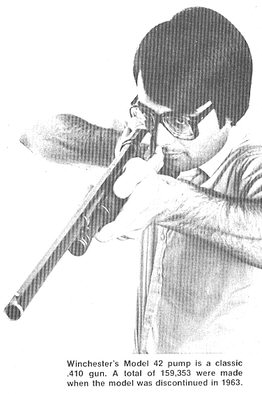
 |
|
|
|
SHOULD A .410 BE IN YOUR BATTERY? Its survival assured by its role in skeet shooting, the .410's usefulness in the field is best realized by good wing shots who understand its limitations. By Robert N. Sears. There isn’t much middle ground about the .410. Shotgunners usually either love or hate this smallest of the commonly used shotgun shells. Its history reveals most of the reasons. At the turn of the century, small game was frequently taken by farmers and woodsmen in the course of their daily work as the opportunity presented itself. It was not sport hunting. Sitting birds and rabbits shot at close range were the targets most often finding their way to the pot. A small load of fine shot did the job without being
overly destructive to the meat. Up to 10 yds. The 44-40 loaded with no. 8
shot was usually adequate, although the pattern was wide when fired from a
rifled bore. The Stevens Pocket Shotgun chambered for the .44-50 (2” and
.44-65 2˝”)
shells were better, but the brass cases were never available as loaded
ammunition. The .44 XL cartridge was not quite their equal but, being
factory loaded, became much more popular and outlasted them for many
years. An epochal development in guns for the purpose was reached with the
introduction of the Marble’s Game Getter in 1908, Its top barrel took
.22 rimfire cartridges, while the smoothbore lower barrel took at least
four different .44 cartridges, including the 115-gr round-ball load. |
 |
|
|
Paper-cased shotshells were highly developed by that
time. Naturally, a small one was sought for this kind of gun. The simple
answer was found in a 2”-long (50 mm) paper case used in Germany for gas
cartridges. It fired no projectile, so the barrel of pistols that used it
were bored through to the chamber diameter of .472” (12 mm). The .410
bore gun and shell originated about 1911, when this case was loaded with
shot and the bore diameter reduced to .410” (10.4 mm). This interesting
beginning seems to have been overlooked until now. |
Reprinted curtesy of :- The
Author :- Robert N. Sears |
|
|
Should a .410 be in your battery? - Page 1 |